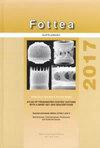类聚球菌蓝藻的系统发育与分类
IF 1.4
3区 生物学
Q3 PLANT SCIENCES
引用次数: 37
摘要
单细胞蓝藻是淡水和海洋微生物群落中重要的生态组成部分。孤立的、细长的蓝藻细胞,没有明显的黏液包膜,在垂直于纵轴的单个平面上分裂,传统上被归类为聚球藻属。该模式物种起源于淡水底栖栖息地,而其他一些类似聚球藻的物种则来自不同的环境。形态相似的“聚球藻”单细胞种群属于生活在淡水和海洋微微浮游生物群落中的最富氧进化原核生物。来自极端高温栖息地的其他物种在温度超过70°C时被描述。最近的分子分析,特别是类聚球藻物种的16S rRNA基因和其他基于多位点基因的系统发育分析,揭示了这种简单蓝藻的多系性和系统发育多样性,强调了对其进行准确的多相分类重新分类的必要性。为了更好地了解不同类聚球藻物种的系统发育,我们使用133个蓝细菌和真细菌基因组以及16S rRNA基因系统发育树构建了一个基因组衍生的系统发育树。这两棵树都表明,单个聚球藻谱系之间存在着深刻的分裂,对应着模糊的生态和细胞形态差异。基于综合性状和标记,从聚球藻属的传统概念中衍生出的属属单元必须得到定义和有效描述。本文讨论了与聚球藻属相似的各种形态类型和基因型(蓝球藻、副粘球藻、小粘球藻,原绿球藻、热粘球藻和热粘球虫)的系统发育簇的比较分类。本文章由计算机程序翻译,如有差异,请以英文原文为准。
Phylogeny and taxonomy of Synechococcus-like cyanobacteria
Unicellular cyanobacteria constitute a substantial, ecologically important part of freshwater and marine microflora. Solitary, elongated cyanobacterial cells without apparent slime envelopes and dividing in a single plane perpendicular to the longitudinal axis were traditionally classified into the genus Synechococcus. The type species originates from a freshwater benthic habitat while a number of other Synechococcus-like species were described from diverse environments. Morphologically similar, unicellular populations of "Synechococcus" belong to the most abundant oxygen evolving prokaryotes inhabiting freshwater and oceanic picoplanktic communities. Other species from extreme thermal habitats were described from temperatures over 70 °C. Recent molecular analyses, particularly the 16S rRNA gene and other multi-locus gene based phylogenies of Synechococcus-like species reveal the polyphyly and phylogenetic diversity of such simple cyanobacteria emphasizing the necessity of their accurate polyphasic taxonomic re-classification. To better understand the phylogeny of different Synechococcus-like species, we constructed a genome-derived phylogenetic tree using 133 cyanobacterial and eubacterial genomes as well as a 16S rRNA gene phylogenetic tree. Both trees indicate existence of deep splits between individual Synechococcus lineages corresponding with indistinct ecological and cytomorphological differences. The generic units derived from the traditional concept of the genus Synechococcus based on the combined traits and markers must be defined and validly described. The comparative taxonomic classification of phylogenetic clusters corresponding to various morphotypes and genotypes similar to the genus Synechococcus (Cyanobium, Parasynechococcus, Picosynechococcus, Prochlorococcus, Thermosynechococcus, Thermostichus) are discussed in the article.
求助全文
通过发布文献求助,成功后即可免费获取论文全文。
去求助
来源期刊

Fottea
生物-植物科学
CiteScore
4.00
自引率
9.10%
发文量
20
审稿时长
>12 weeks
期刊介绍:
Fottea is a journal of Czech Phycological Society (formerly bulletin Czech Phycology). Fottea publishes papers on all aspects of the ecology, physiology, biochemistry, cell biology, molecular biology, systematics and uses of algae (including cyanobacteria)
 求助内容:
求助内容: 应助结果提醒方式:
应助结果提醒方式:


